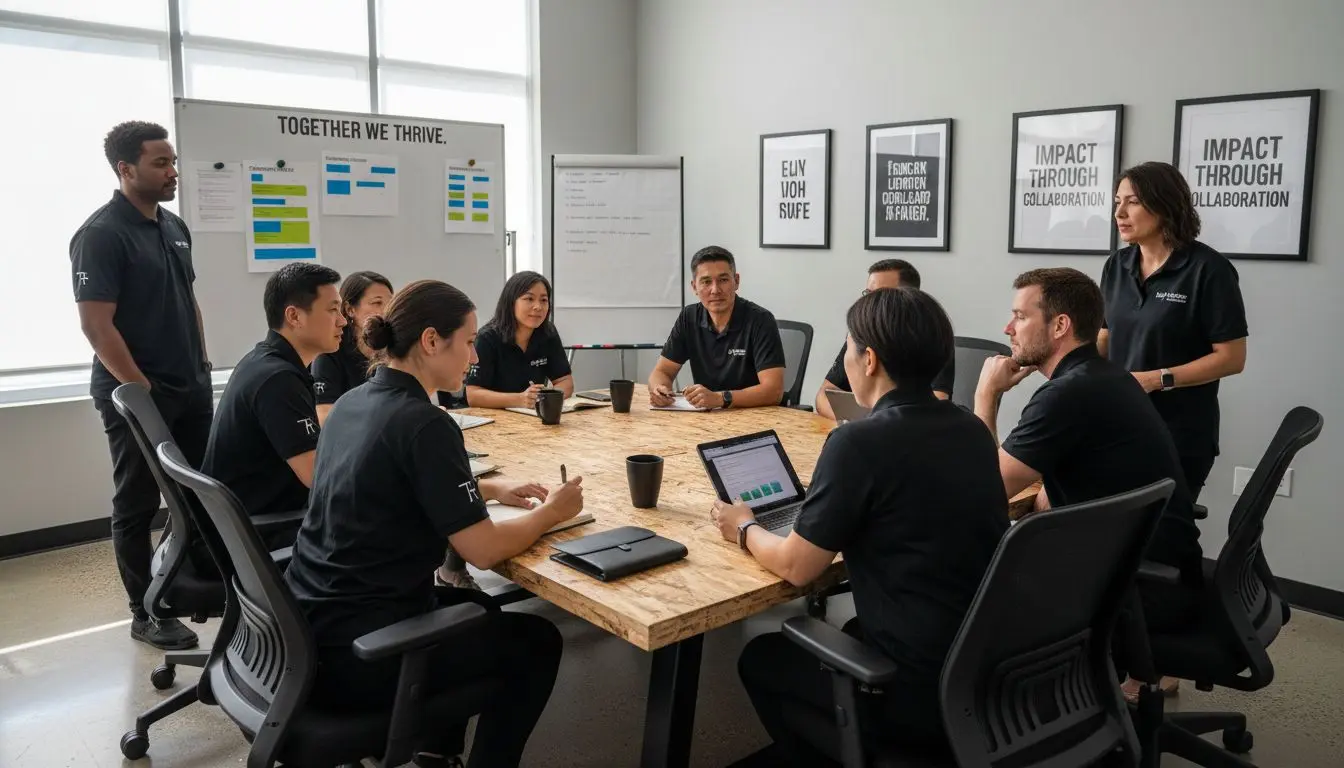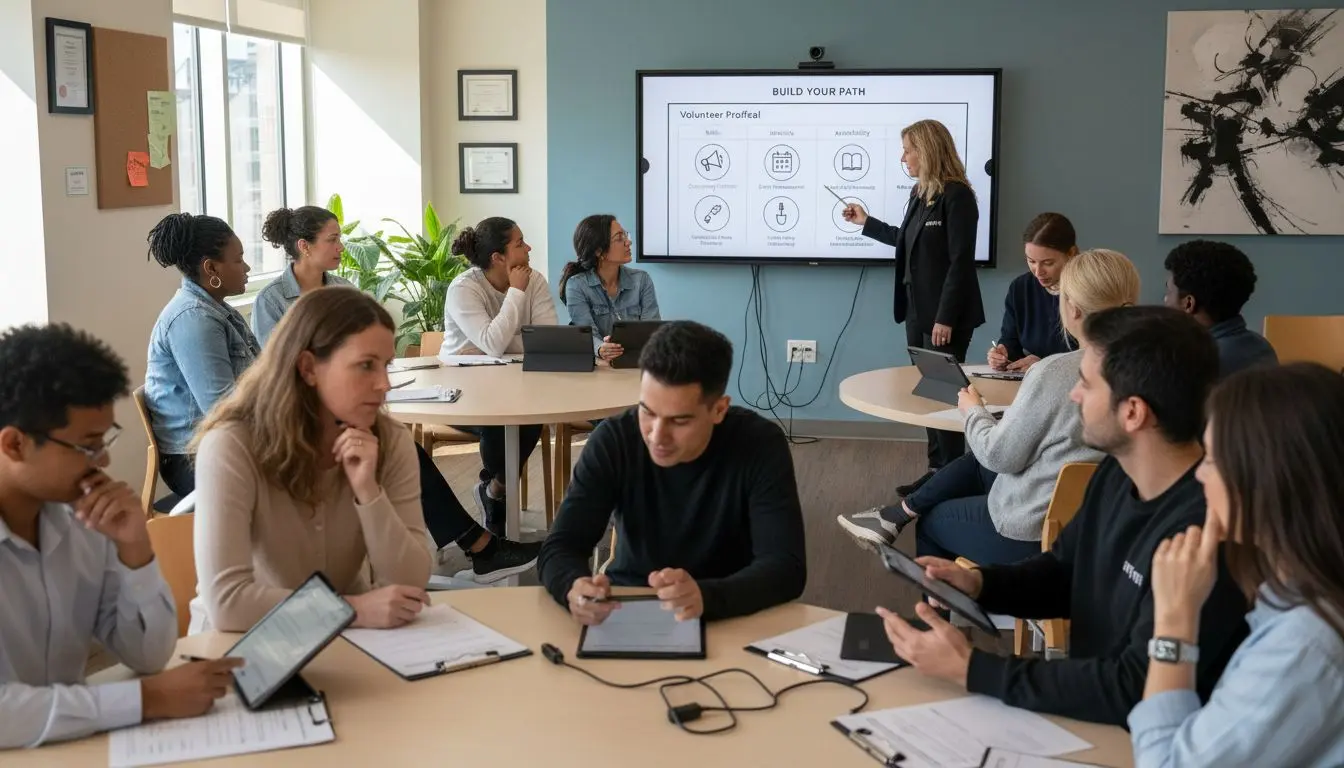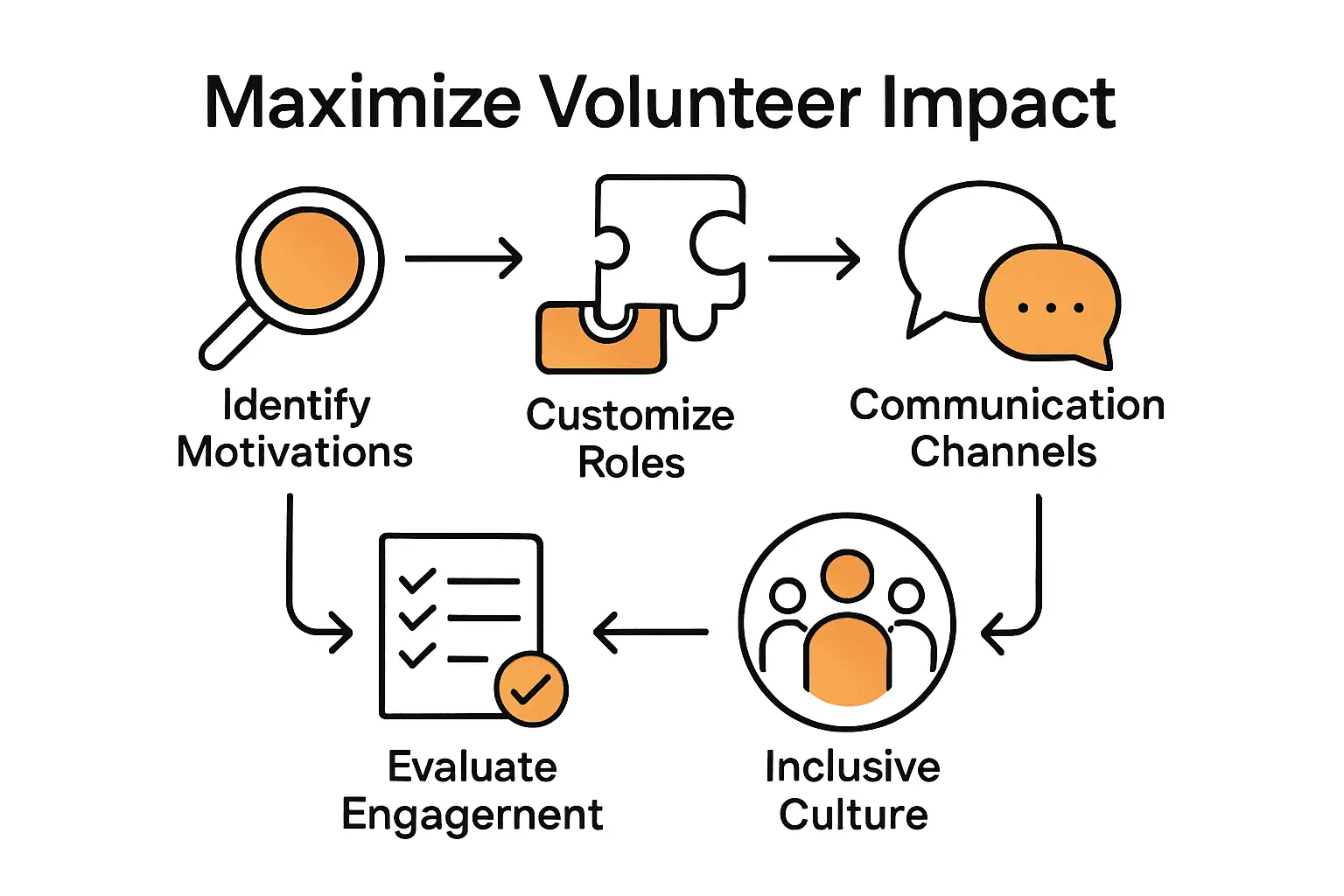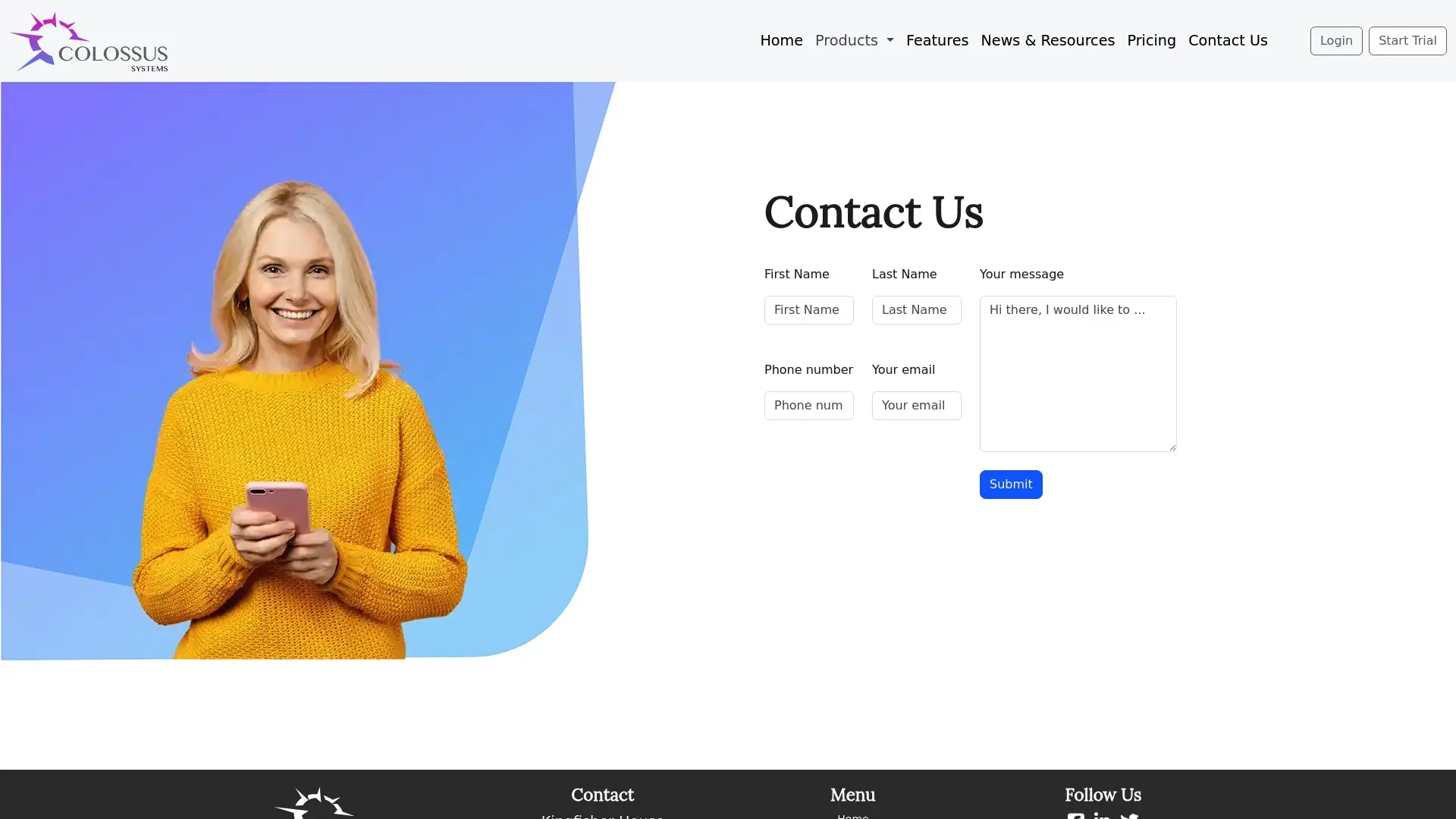How to Engage Volunteers for Maximum Impact

More than 60 percent of volunteers say their satisfaction hinges on feeling valued and well matched with meaningful work. When organisations understand what drives volunteers, they turn good intentions into lasting contributions. Learning exactly how to identify, engage, and support volunteers helps you create an environment where every person feels motivated and appreciated. Discover practical steps for deepening volunteer commitment and building a community that thrives on shared purpose.
Table of Contents
- Step 1: Identify Volunteer Motivations And Needs
- Step 2: Customize Volunteer Opportunities And Roles
- Step 3: Implement Effective Communication Channels
- Step 4: Foster An Inclusive And Supportive Culture
- Step 5: Evaluate Engagement And Gather Volunteer Feedback
Quick Summary
| Key Point | Explanation |
|---|---|
| 1. Identify Volunteer Motivations | Understand what drives volunteers through interviews and surveys to match roles effectively. |
| 2. Customize Volunteer Roles | Tailor opportunities based on individual skills and interests for increased engagement and satisfaction. |
| 3. Create Clear Communication Channels | Develop multi-channel communication strategies to keep volunteers informed and connected to the mission. |
| 4. Foster an Inclusive Culture | Build a welcoming environment that values diversity and personal growth to enhance volunteer retention. |
| 5. Regularly Evaluate Engagement | Implement feedback mechanisms to assess volunteer satisfaction and adapt strategies over time. |
Step 1: Identify Volunteer Motivations and Needs
Successfully engaging volunteers starts with understanding what drives them to contribute their time and energy. This step focuses on uncovering the underlying motivations that will help you create meaningful volunteer experiences.
According to research from PubMed, the Volunteer Functions Inventory (VFI) reveals six key motivational categories that organizations should consider: values, understanding, social connection, career development, personal protection, and personal enhancement. By mapping these motivational dimensions, you can design roles that genuinely resonate with potential volunteers.
To effectively identify volunteer motivations, start by conducting individual or group interviews that explore their personal goals and interests. Ask open ended questions like “What inspired you to volunteer?” or “What do you hope to gain from this experience?” The systematic review from RSI International highlights that motivations are typically split between intrinsic factors (personal growth, altruism) and extrinsic factors (social recognition, career advancement).
Develop a short survey or assessment that helps volunteers self identify their primary motivation type. This might include options like:
- Contributing to a meaningful cause
- Learning new skills
- Meeting like minded people
- Professional networking
- Personal development
- Community impact
By understanding these nuanced motivations, you can match volunteers with roles that align with their personal objectives.
 This strategic approach increases volunteer satisfaction, retention, and overall organisational impact. Learn more about retaining volunteers in our comprehensive guide on volunteer engagement.
This strategic approach increases volunteer satisfaction, retention, and overall organisational impact. Learn more about retaining volunteers in our comprehensive guide on volunteer engagement.
Remember that motivations are complex and can change over time. Regular check ins and flexible role assignments will help you maintain strong volunteer relationships.
Step 2: Customize Volunteer Opportunities and Roles
After identifying volunteer motivations, the next critical step is creating tailored roles that align with their individual interests, skills, and personal objectives. This strategic approach ensures volunteers feel valued and engaged throughout their experience.
Research from arXiv introduces the Skill and Willingness-Aware Volunteer Matching (SWAM) algorithm, which demonstrates the importance of precisely matching volunteers to tasks based on their unique capabilities and preferences. By implementing a systematic approach to role assignment, organisations can significantly enhance volunteer satisfaction and organisational efficiency.
To effectively customize volunteer opportunities, start by developing a comprehensive skills and interests assessment. This should go beyond basic demographic information and explore specific competencies, professional backgrounds, and personal passions. Research from HRMARS highlights that aligning roles with individual motivations particularly increases engagement among younger volunteers.
Consider creating a flexible role framework that allows volunteers to:
- Select tasks that match their skill set
- Rotate between different types of responsibilities
- Choose time commitments that suit their schedule
- Participate in roles with clear learning and development potential
Provide volunteers with multiple pathways for involvement, recognising that their interests and availability may evolve over time. Learn more about donor management strategies in our comprehensive guide to understand how personalised engagement can transform volunteer relationships.
Remember that successful volunteer customisation is an ongoing process.
Regular feedback sessions and adaptable role structures will help you maintain a dynamic and motivated volunteer workforce.
Step 3: Implement Effective Communication Channels
Creating robust communication channels is essential for maintaining volunteer engagement and ensuring a smooth, supportive experience for your team. This step focuses on developing a comprehensive communication strategy that keeps volunteers informed, motivated, and connected to your organisation’s mission.
Research from Volunteering Australia emphasises that effective communication strategies directly impact volunteer satisfaction. By providing clear role descriptions and consistent feedback, organisations can significantly enhance volunteer commitment and motivation.
Develop a multi channel communication approach that caters to different volunteer preferences. This might include:
- Email newsletters with organisational updates
- Private messaging groups on platforms like Slack or WhatsApp
- Regular virtual or in person team meetings
- Quarterly feedback surveys
- Personal check in calls
A comprehensive study from Springer Link underscores the importance of transparency, highlighting that clear communication about organisational goals and volunteer expectations directly correlates with higher retention rates. This means being open about your mission, the impact of volunteer work, and providing context for each task or project.
Explore our guide on digital communication strategies for member organisations to further refine your approach to volunteer engagement.
Remember that communication is a two way street. Create opportunities for volunteers to share feedback, ask questions, and feel genuinely heard. Regular, authentic communication builds trust and strengthens your volunteer community.

Step 4: Foster an Inclusive and Supportive Culture
Building a welcoming and supportive environment is crucial for volunteer retention and engagement. This step focuses on creating a culture that values diversity, respects individual contributions, and provides meaningful opportunities for personal and professional growth.
Research from Academic Oxford highlights the importance of recognising diverse motivations, including religious and community values. An inclusive environment that accommodates various personal backgrounds and perspectives can significantly enhance volunteer commitment and satisfaction.
To create a truly supportive culture, consider implementing strategies such as:
- Regular team building activities
- Personalised recognition programmes
- Mentorship and skill development opportunities
- Inclusive decision making processes
- Flexible volunteer roles that accommodate different life circumstances
A comprehensive study from MDPI emphasises that addressing volunteers’ emotional needs and providing personal development opportunities can reduce emotional exhaustion and increase overall satisfaction. This means creating an environment where volunteers feel valued, heard, and supported beyond their immediate tasks.
Explore our guide on understanding diversity and inclusion strategies to deepen your approach to building an inclusive volunteer culture.
Remember that an inclusive culture is an ongoing commitment. Regularly seek feedback, be open to learning, and demonstrate genuine appreciation for the unique contributions each volunteer brings to your organisation.
Step 5: Evaluate Engagement and Gather Volunteer Feedback
Understanding and measuring volunteer engagement is crucial for creating a dynamic and responsive organisational environment. This step focuses on developing systematic approaches to assess volunteer satisfaction, identify areas of improvement, and track long term engagement trends.
Research from arXiv introduces the Multidimensional Crowdworker Motivation Scale (MCMS), a comprehensive framework for evaluating volunteer motivations across six distinct dimensions. This approach allows organisations to gain deep insights into volunteer experiences and motivational factors that drive sustained participation.
Design a robust feedback mechanism that includes multiple evaluation strategies:
- Quarterly satisfaction surveys
- One on one feedback interviews
- Anonymous suggestion platforms
- Performance and engagement tracking
- Periodic motivation assessments
A longitudinal study from Springer Link emphasises the critical nature of continuous feedback collection. By consistently assessing both intrinsic and extrinsic motivations, organisations can adapt their strategies to evolving volunteer needs and maintain high levels of engagement.
Learn more about engagement metrics in our comprehensive guide to refine your approach to volunteer evaluation.
Remember that feedback is a two way conversation. Be transparent about how you will use the insights gathered and demonstrate tangible changes based on volunteer input. This builds trust and shows that you genuinely value their contributions.
Boost Volunteer Engagement with Tailored Digital Solutions
Volunteers bring passion and dedication, yet matching their unique motivations and skills to the right roles while maintaining clear communication can be challenging. The article highlights key steps such as identifying volunteer motivations, customising opportunities, and fostering an inclusive culture — all crucial but complex to manage manually. Organisations often struggle to keep volunteers motivated, informed and connected, risking lower satisfaction and retention.
Colossus Systems offers a unified platform designed specifically for membership-based organisations to overcome these hurdles. Our tools streamline volunteer and member management, offer flexible event planning, sophisticated CRM, and integrated communication channels that adapt to evolving volunteer needs. By leveraging these capabilities you can personalise roles, track engagement seamlessly, and build an inclusive community that retains passionate volunteers longer.
Start transforming your volunteer engagement today by exploring how to retain volunteers effectively with our resources (Volunteer Engagement Guide) and learn more about streamlining your organisational operations in our donor management guide.

Ready to empower your volunteers and maximise their impact Use our comprehensive digital solutions platform to create meaningful and personalised experiences that drive long term commitment. Connect with us now to explore the possibilities at Colossus Systems and make a difference in your volunteer management strategy.
Frequently Asked Questions
How can I identify volunteer motivations effectively?
To identify volunteer motivations, conduct individual or group interviews that explore personal goals and interests. Use open-ended questions like ‘What inspired you to volunteer?’ to uncover their motivations and develop tailored opportunities.
What steps can I take to customize volunteer roles?
To customize volunteer roles, create a skills and interests assessment that covers specific competencies and passions. Allow volunteers to select tasks that align with their skills and provide options for flexible scheduling and rotation of responsibilities.
What communication strategies enhance volunteer engagement?
Implement a multi-channel communication approach, using email newsletters, messaging groups, and regular team meetings. Ensure clear role descriptions and consistent feedback to keep volunteers informed and motivated.
How can I foster an inclusive culture for volunteers?
To foster an inclusive culture, prioritize team-building activities and create personalized recognition programs. Encourage flexible volunteer roles and include volunteers in decision-making processes to make everyone feel valued.
What methods should I use to evaluate volunteer engagement?
Utilize multiple evaluation strategies like quarterly satisfaction surveys and one-on-one feedback interviews to assess volunteer engagement. Gather insights regularly to adapt your approach based on evolving volunteer needs to maintain high satisfaction levels.
Recommended
- How to Retain Volunteers: Enhance Engagement and Commitment|CS
- 7 Effective Youth Engagement Strategies for 2025 | Colossus Systems
- Effective Community Engagement Tactics for Lasting Connections|CS
- Understanding Successful Advocacy Campaigns for Impact|CS
- Understanding Community Event Planning Guide for Everyone - WhenNOT Blog